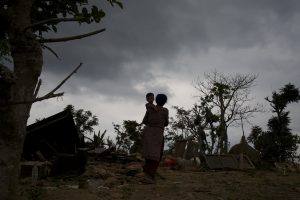Nepal faces the risk of further earthquakes and landslides which would heap further misery on the impoverished country after a 7.8 magnitude earthquake on April 25 killed thousands of people and pulverised the country’s infrastructure.
The UN estimates that over 8 million people are in need of humanitarian assistance, about a quarter of the country’s population.
Last week’s disaster is the country’s worst since a 1934 tremor that killed nearly 17,000 people across both India and Nepal, but earthquakes can be much more regular in a region that is one of the most seismically active zones in the world.
Every time the Indian and Eurasian plates collide, severe strain builds up below the Himalayas, stress that is released periodically in the form of massive tremors.
Other major recent earthquakes in the densely populated Himalayan region include the 7.6 magnitude Kashmir earthquake in 2006 and the 6.9 magnitude Sikkim earthquake in 2011.
Barely two months before last week’s catastrophe, a team of geologists warned that the region was overdue for a major earthquake, pointing out that a 700 km-long section of the central Himalayas, home to around 10 million people, had not ruptured over the last 200-500 years.
Another recent study by Indian seismologist CP Rajendran had also anticipated a large earthquake in precisely the location where Saturday’s quake occurred.
Last week’s high powerfully quake was probably not big enough to release the underground stress that had been building up for centuries, meaning another big earthquake is likely to occur in the next few decades, Rajendran told thethirdpole.net.
Meanwhile, the after-shocks in Nepal could continue for a month, he said.
Landslide damage
In places like Nepal, landslides can be as deadly as the earthquake quake itself, causing up to half of the casualties.
“The Himalayas are the landslide hotspot of the world,” says Professor Dave Petley, pro-vice chancellor at the University of East Anglia who has studied landslides in Nepal for many years. “This is because of the combination of active tectonics, which are pushing up the mountains making them taller and steeper, weak soils because of the high rates of weathering, high levels of monsoon rainfall, occasional large earthquakes and the presence of people (i.e high population density),” he says.
The steep topography in the area of the epicentre, and the high intensity of shaking mean that thousands of landslides are likely to have been triggered by the earthquake, Robert Parker, a researcher with Cardiff University’s School of Earth and Ocean Science, told the BBC.
The extent of the devastation in rural Nepal is only just becoming apparent, as bad weather has hampered relief workers and helicopters trying to reach the worst affected areas.
Initial reports trickling in from survivors are chilling. Landslides and avalanches appear to have wiped out entire villages in the Langtang valley, Sindhupalchowk, Rasuwa and Dhading districts near the epicentre.
Houses in rural Nepal are made of thin walls (most often stone or adobe) and heavy roofs, all of which have very low resistance to earthquakes.
Scientists fear that the monsoon rains may trigger further landslides in the area where rocks have already been loosened and dislocated by the quake. One of the biggest concerns is temporary dams that can build up when a landslip blocks a river’s natural course.
“We will expect to see existing landslides reactivate, loose debris move as damaging debris flows, and new landslides on slopes weakened by the shaking. There is a need to take measures ahead of the monsoon if at all possible,” said Petley.
Scientists also say the earthquake that triggered avalanches in the Everest region may have destabilised glacial lakes there, which could burst and submerge areas downstream.
Large dams
Dams and other large infrastructure are particularly vulnerable to collapse, triggering further landslides and flooding.
K.S. Valdiya, professor at the Jawaharlal Nehru Centre for Advanced Research has long cautioned against building large dams in the seismically active Himalayas that are regularly ravaged by excessive rains and landslides.
Excavations for quarrying, mining, and road building can destabilise slopes, triggering continuous rock falls, landslides and debris avalanches, said Valdiya, writing in a June 2014 report in Current Science.
Experts say the collapse of a dam near the China-Nepal border in last week’s earthquake should prompt a rethink across the Himalayan countries about the wisdom of building dams on seismic fault lines.


